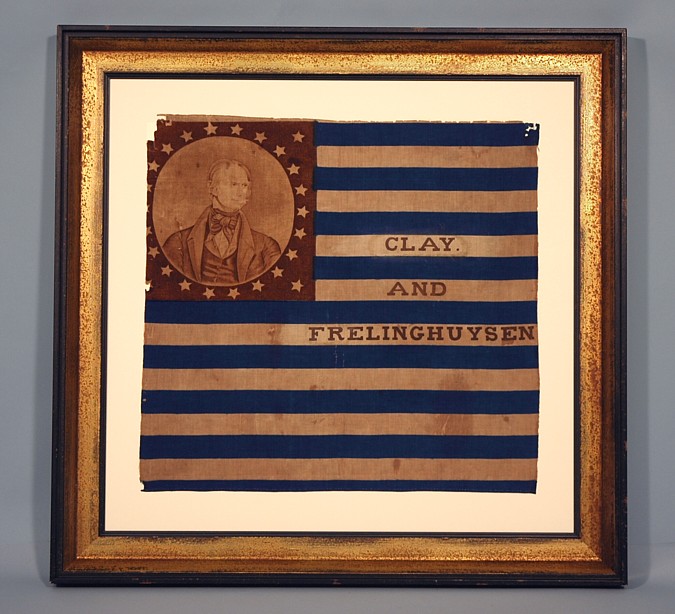
| |
ONE OF ONLY TWO KNOWN EARLY AMERICAN FLAGS WITH BLUE & WHITE STRIPES, |
|
| Available: |
Sold |
| Frame Size (H x L): |
35.25" x 36.25" |
| Flag Size (H x L): |
24.25" x 25.5" |
|
| Description....: |
|
| ONE OF ONLY TWO KNOWN EARLY AMERICAN FLAGS WITH BLUE & WHITE STRIPES,
A RARE, PORTRAIT-STYLE PARADE FLAG FROM THE 1844 PRESIDENTIAL CAMPAIGN OF HENRY CLAY:
26 star American parade flag, printed on cotton, made for the 1844 campaign of Henry Clay. Clays portrait appears inside a wreath of stars, and overprinted in the stripes are the words: Clay And Freylinghuysen.
This is a particularly visual flag with some exceptional and unusual characteristics. The most obvious of these are the stripes, which are a rich, cobalt blue instead of red. This same Clay & Freylinghausen parade flag also exists with red stripes, but it is both more common in that format and less interesting. Only two copies, including this one, are currently known to exist in the blue striped variation. These two blue and white striped flags are unique among known Stars & Stripes, as no others exist in either sewn or printed flags.
The reason for making the stripes blue instead of red is unrecorded, but a few early flags are known that include red, white, and blue stripes. These tri-color striped flags are very rare, only a handful have survived to the present day, but the presence of only blue and white stripes is even more so.
Also note that the flag has 17 stripes instead of the official 13. This may serve no particular purpose, as there are numerous early flags that do not have the correct stripe count. The choice of 17 vs. 13 may simply be due to the fact that the person who designed the flag liked it better that way from a graphics standpoint. But I think the number 17 had a particular meaning to Clay, who became a U.S. Senator in 1806, during the period in which we had 17 states. Clay was just 29 years old at the time. A special exception was made because he was younger than 30 years old, the minimum age required by Constitutional law. This was the beginning of a nearly uninterrupted 46-year term in the House and Senate, where he served as both Speaker and Chairman, respectively.
Among the flag's other interesting features are its circular star pattern and interesting portrait of Clay with exaggerated features. It is likely that the flag's squarish proportions (its original form) were intended to mimic infantry battle flags and other military standards of the time, most of which had this relatively square shape.
The 26 star flag became official on July 3rd, 1837, after the addition of Michigan. It remained the official star count until 1845. The earliest known parade flags have either 26 or 13 stars, and were made within this 8-year period. Parade flags do exist from the 1840 campaign of William Henry Harrison, and while the Clay/Polk campaign was four years later, in 1844, this still means the Henry Clay campaign flags, while not the first, are still among the earliest printed parade flags known to exist. Further, political campaign flags are among the most valuable of all Stars and Stripes.
Call for more information. |
|
|
|
| Collector Level: |
|
|
| Flag Type: |
Parade flag |
|
| Star Count: |
26 |
|
| Earliest Date of Origin: |
1844 |
|
| Latest Date of Origin: |
1844 |
|
| State/Affiliation: |
Michigan |
|
| War Association: |
1777-1860 Pre-Civil War |
|
| Price: |
No |
|
| |
Views: 3436 |
|
|
|

